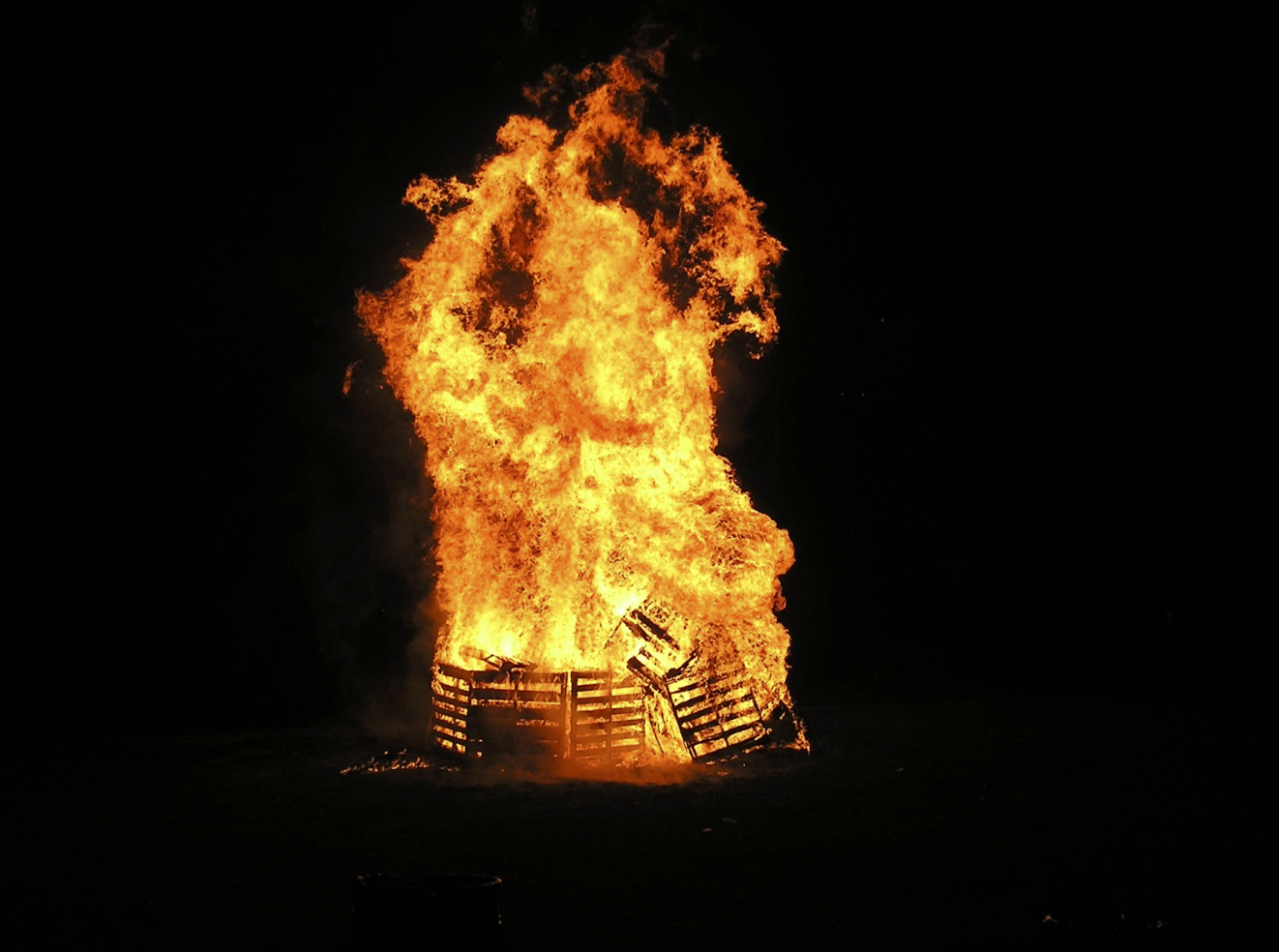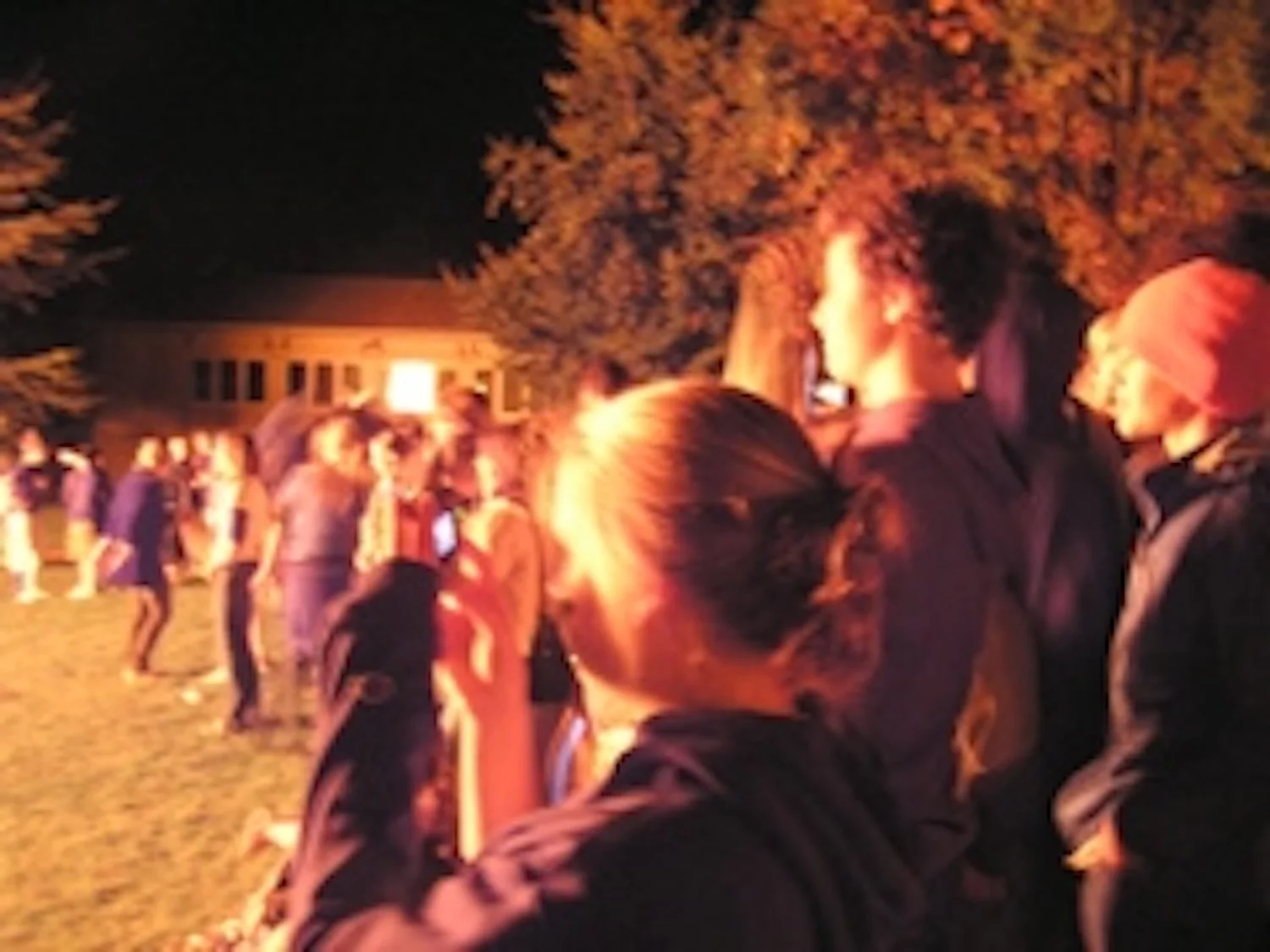The lost traditions of Catlin Gabel
By Krish Caulfield ‘26
The Homecoming bonfire on the hill where the CAC is now located.
Photo by Sue Phillips.
The dinner table was always a little too small. Faculty and seniors squeezed amongst clusters of chairs, sprawling from the dining room to the back deck, extending over a buffet that curled through the kitchen. Relaxed, unforced conversation wove its way through glasses, plates, and utensils.
Many students know the lore of defunct Catlin Gabel School (CGS) traditions like the Rummage Sale or St. George, but there is far more. Within the mythology of this school lie tales of twenty-foot conflagrations, of sophomores reciting excerpts of The Canterbury Tales at the behest of their senior peers, and of conversations sparked by the forgotten senior-faculty dinners.
These senior-faculty dinners began in the early 2000s. Cohorts of seven or eight teachers co-hosted at colleagues’ homes in the fall, and students returned the gesture come spring.
“They’d just show up and we’d have a lovely time having a leisurely conversation, sitting down to dinner together, and just talking as peers around the table,” said Sue Phillips, current Upper School librarian and twenty-one-year veteran of the school. “It was just friendly and kind … it felt to me such a good way of cementing relationships with students.”
There would be six to ten students in the cohort with the teachers, and the cohort’s members would change in the spring. During fall dinners, teachers dispersed among the students, supporting the flow by offering replenishments of beverages or dishes, but at its best, Phillips mentions, it was “very comfortable and natural.”
Upper School science teacher Marguerite McKean ‘04 thinks of the senior-faculty dinners as a sign of faculty welcoming students “as potential colleagues, as thought partners, as adults who were burgeoning into that sphere.”
“I think that the seniors felt deeply respected for being invited,” Phillips added, “and I think they were probably curious about their teachers' houses.”
Former Upper School science teacher Bob Sauer reminisced about sharing his Middle Eastern culinary skills and his extensive CD collection of soundtracks and Broadway musicals with students while hosting dinners. Sauer said that he enjoyed showcasing another side of himself with seniors as they would soon depart the school.
By the early 2010s, the tradition faded—sign-ups thinned on both the student and faculty ends, and a push for a breakfast option fell short due to weaker attendance. “It was a slow decline,” said Phillips. She mentioned that the downfall of the dinners seemed to signal that people, more pressured and stressed than before, “were looking at school in a more matter-of-fact way and not viewing it quite as much in terms of relationships.”
Sauer assessed that “it was very hard to get people to be willing to host things, and it took a lot of organizing, too.” Behind the dinners, particularly on the student end, was the challenge of getting enough families across the class to open their homes to roughly fifteen guests.
Phillips mentioned that technology and the reality that “everyone was on their phones more often” seemed to contribute to changes in relationships between students and teachers. Sauer said he concurred, adding that “the digital” became a significant part of what students did outside of class, changing their relationships with faculty in the process.
If senior-faculty dinners were about making connections in the present, then senior gifts were about preserving a legacy for the future. Since before Sauer’s time, class advisors and students debated how a class could leave something useful behind for the CGS community.
Past gifts included murals, the bike rack on the south side of the Upper School Library, and seating across campus, including many of the notorious senior benches. “When alumni come back ten, twenty years later, they always come looking for the class gift,” Phillips said.
The cycle-shaped bike racks keeping Ari Wilda ‘26 (left) and Derek King's (right) bikes safe.
Photo by Krish Caulfield ‘26.
Phillips fondly speaks of her favorite senior gift, which was “messy and delightful.” In the early 2010s, seniors repainted the U.S. map that had been etched on the pavement between the Barn and the Fir Grove with their first-grade buddies. The map was far from geographically accurate, with splatters of paint bleeding across state lines.
“Sometimes it’s as simple as that: just a show of friendship and kindness and something that people walk across without a thought,” Phillips said. “It wasn’t great art, but it was adorable.”
Phillips partially attributed the downfall of the gifts to the reality that spring is crowded with AP exams, senior projects, and global trips. She added, “Seniors get busy in the spring … They’re thinking about ‘Okay, what’s life beyond here now?’” Lost amid that scramble is what they could leave before they depart for what’s beyond.
It’s worth noting that the Class of 2026 Parent-Faculty Association (PFA) leaders are working alongside senior class advisors Enrique Escalona and Elizabeth Gibbs, as well as the students, to settle on a gift for the class to bestow upon the school (and themselves). A tradition reignited, perhaps?
Speaking of ignition, long before our time, during Homecoming, members of Art Leo’s C&C would skip the big game and wire together roughly cut pine shipping pallets into an imposing tower—tall enough to be noticed from the parking lot. As the second Homecoming game concluded, the C&C members would get word to ignite an inferno, which would inevitably attract the attention of CGS’s neighbors at St. Vincent’s and eventually, the fire department.
The blaze, which took place on the hill that houses the Creative Arts Center (CAC), was what Phillips called “an ancient spectacle.” Students would gather for hours after the game, under adult supervision, including but not limited to former Upper School Head Emily Jones, wielding a hose plugged into the water spigot from the Dant House. Sauer noted the persistence of the “blackened spot on the lawn” in the weeks following the fire.
Another angle of the Homecoming bonfire.
Photo by Sue Phillips.
The tradition ceased around 2010, due to what Phillips speculated may have been insurance and permit concerns.
McKean and Sauer also recalled a few smaller, day-long, and “Hogwarts”-esque (as Sauer characterized them) traditions that sparked community.
During McKean’s time at CGS, all sophomores would learn, in Middle English, the first eighteen lines of Geoffrey Chaucer’s The Canterbury Tales. For a single day—Chaucer Day—members of the faculty, as well as seniors, would step into the role of “Summoner,” obtaining the glorious ability to make any sophomore recite the prologue to the book. “It was kind of a hazing ritual,” recalled McKean, “but [it was] also kind of a rite of passage.”
She also remembered Hester Prynne Day, where students would literally rock a scarlet letter, often dangling from their necks, inspired by Nathaniel Hawthorne’s The Scarlet Letter. Similarly, Sauer recalled Noah’s Day, which was always March 4—as in the biblical tale, Noah told the animals to “march forth.” Students who wished to partake would bring a stuffed animal to school.
Hester Prynne Day and the iconic letters sported by students.
Photo from the 2002-03 CGS Yearbook.
These two traditions are reminiscent of Catlin’s current spirit week agendas, in which smaller rituals, often rooted in clothing or accessories, foster community over a single day or week.
McKean and Sauer also brought up the past structure for class trips—an approach that could promote community over a few days or a week, but away from campus. Both the ninth graders in the fall and the seniors in the spring would travel to Camp Cody. The ninth graders would typically engage in an environmental restoration project, often fence-building.
“I loved being a part of the long-standing tradition of going to Camp Cody,” McKean remarked.
She added that doing “scary things” and “hard things” as part of tradition when she was a student has faded. “There's been a large cultural shift,” she said, referring to the evaporation of demanding, service-oriented traditions. She cited John Harnetiaux as a positive force within the community in terms of working to re-establish that work.
The seniors' return to Camp Cody marked what Sauer described as “a final chance to bond together” before they moved on from the CGS community; the trip was a full-circle moment for students to finish their time at CGS.
Students scale a cliff during a trip.
Photo from the 2012-13 CGS Yearbook.
Phillips remembers many of these rituals less for the delicious food or the warmth of the fire, but more for the pace they set. “It felt like a slightly simpler time where people made a little more time for each other and made a little more time for relationships,” she said. Traditions are tools that reflect values and culture, thereby shaping how communities feel.
The loss of these traditions is the kind that Professor Peter K. Bol, a Harvard scholar of Confucian thought, may describe in terms of ritual. In an interview on The Happiness Lab podcast, he remarked that rituals are not performative but about action. “Ritual is doing, not thinking, not speaking. Ritual is doing.”
Through tradition, Bol asserts that “we not only can self-cultivate and become better people, but we need to self-cultivate and become better people.” The Oregon Counseling Center adds that this sense of self-cultivation inherently fosters “being, belonging, believing, and benevolence.”
However, McKean noted that certain traditions, like the Chacuer Day recitations, are “not going to be welcoming to everybody” because of their on-the-spot nature. She commented that there’s been a perceptible shift in the school's values from her time as a student to her time as a teacher: she said the school’s former idea that “your value is as much in your academic achievement as it is in your humanity” contributed significantly to who she is, though it may not have been the best approach for all.
The right traditions, however—those that bring students together through community service or enable us to generate an appreciable sense of belonging that otherwise would not manifest—manage to put our value far more in our humanity than anything else. We self-cultivate.
“Ritual is almost meditative in some ways,” McKean said. “By the time I was in twelfth grade and I had been through those rituals several times, the sense of belonging was so palpable because I knew what they were. I knew what to do, and I could welcome someone new into it as well.”
That framework of thinking clarifies where the quiet disappearance of these CGS traditions mattered most. CGS rituals are about how the community practices actually being a community. They present opportunities to, as Phillips puts it, find “common ground” and “points of connection.”
These forgotten traditions—even the conflagration where the CAC now stands—were never really just about the spectacular aspects. They were instead about shaping how it feels to stand within the CGS community. Maybe, as traditions slip away, the work of cultivating self within this community, of putting our humanity first, begins with remembering where we once stood and making a little more time for one another.





